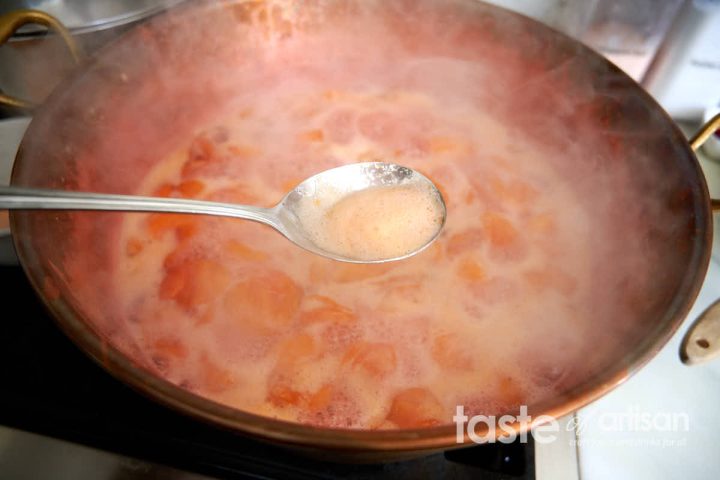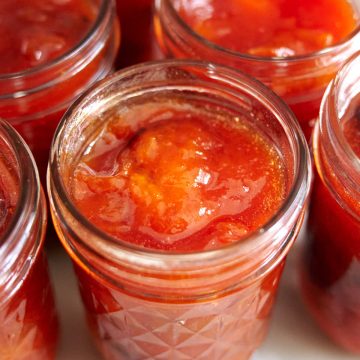I enjoy homemade apricot jam as much as my all-time favorite strawberry jam. I like my apricot jam chunky, just like the strawberry jam. This requires an extra step during cooking to protect the fruit from softening too much and disintegrating, but it's absolutely worth it. The texture of this jam is thick and a bit chewy, like very soft caramel. It's sweet and tart at the same time, with a very balanced taste. I often add some sour cherries to this jam to increase flavor complexity. Apricots and sour cherries pair exceptionally well.

About this recipe
This recipe is very simple, with only three ingredients: apricots, sugar, and lemon juice—four if you use sour cherries. No other ingredients are necessary. Simplicity is what makes this jam so special.
I don't use pectin in this recipe; it's not needed. Pectin changes the jam's structure in a way that I don't enjoy. Even though apricots and cherries are low in pectin, adding juice from one lemon thickens the jam very nicely. Usually, increasing sugar helps thicken jams made with low-pectin fruit, but it's not needed in this recipe. I keep sugar on the lower end in my jams, and this recipe is no exception, yet the jam is beautifully thick and jammy.
How to make apricot jam
Maceration
Apricots release juice slowly, so it's best to pit them, cut them in halves, mix them with sugar and lemon juice, and let them macerate overnight in a jam pan covered with cheesecloth. You can also add other fruit, like sour cherries, at this time. By the next morning, plenty of liquid will be in the pan. We are ready to start cooking.

Cooking
Bring the mixture to a boil over medium-high heat, stirring occasionally. Cook for 3 minutes, skimming off the foam, then turn the heat off.


Resting
Place a colander over a large bowl. Transfer the fruit to the colander and let rest for 1 hour.

Removing the fruit from the liquid, then thickening the liquid separately will help the fruit retain a lot of its structure and texture. This will produce a wonderfully chunky apricot jam, with a great texture.

Final cooking
Transfer the liquid drained from the apricots to the jam pan. Bring the liquid to a boil over medium-high heat. Lower the heat to medium and continue cooking until the liquid thickens, stirring as needed. You want to make sure no bits are sticking to the bottom. If you want to expedite this part of the process, you can start cooking at medium-high heat, and drop to medium when you start feeling some sticking when you stir the liquid in the pan with a wooden spatula.
You can gauge the thickness of the liquid by dropping a few drops on a cold saucer. Stop when the desired thickness is achieved.
My favorite way, and a more straightforward way, I should say, is to quickly run a flat wooden spatula across the bottom of the jam pan. If I see a 4-5" trail, the jam has reached the perfect thickness. What I like and what you like regarding how thick the jam needs to be may differ. So, keep that in mind. But if you, like me, make jams often enough, this technique will become a valuable time-saver, and you will quickly become good at it.
Next, add the strained fruit and gently mix it with the thickened liquid in the jam pan.

Bring to a boil and cook briefly for a few minutes until the jam passes the thickness test. Again, you can test it with a cold saucer or do the 'trail test' I described above.

This is it! Our amazing apricot jam is ready.
Storing
What you do next with your apricot jam depends on how long you want to store it.
If you are looking for long-term storage, which is my preferred way to store jam, you need to do canning. Fill sterilized half-pint or pint jars, leaving a 1/2" headspace, close with lids, and process in a boiling-water canner for 10 minutes. Canned apricot jam will keep for up to 2-3 years without much color and taste degradation.

Otherwise, transfer the jam into clean jars, close with tight lids, and refrigerate for up to 3 months.
Freezing is another option for longer-term storage.

Old-Fashioned Apricot Jam
Ingredients
- 5 lbs apricots rinsed, pitted, and halved; optionally, substitute one pound of apricots for one pound of pitted sour cherries.
- 2 lbs white sugar
- lemon juice from one lemon
Instructions
- Place the halved apricots, and the pitted sour cherries if using them, in a jam pan. Add the sugar, lemon juice, and mix well. Cover with a cheesecloth. Macerate overnight at room temperature.
- The next day, bring the mixture to a boil over medium-high heat, stirring occasionally. Cook for 3 minutes, skimming off the foam, then turn the heat off.
- Using a slotted spoon, transfer the fruit to a colander fitted over a large bowl. Let rest for one hour.
- Transfer the liquid drained from the apricots to the jam pan. Bring the liquid to a boil over medium-high heat. Lower the heat to medium and continue cooking until the liquid thickens, stirring occasionally to prevent jam sticking to the bottom. See the post above on how to gauge when the jam is thick enough. If you want to expedite this part of the process, you can start cooking at medium-high heat, then drop to medium heat when you start feeling some sticking when you stir the liquid in the pan with a wooden spatula.
- Next, add the strained fruit and gently mix it with the thickened liquid in the jam pan. Bring to a boil and cook briefly for a few minutes until the jam passes the thickness test. You can test it with a cold saucer or do the 'trail test' I described in the post above.
- Transfer the jam into clean jars, close with tight lids, let cool, and refrigerate for up to 3 months.
Canning apricot jam
- Sterilize mason jars and the lids with bands.
- Fill the hot jars with the hot jam using a clean ladle and a canning funnel, leaving a 1/2" headspace.
- Wipe the rims of the jars, put on the lids and the bands. Tighten the bands finger-tight.
- Process in a water bath canner for 10 minutes (assuming 0 - 1,000 feet above sea level), making sure there is at least an inch of water above the lids. Turn the heat off and let the jars sit in the water for another 5 minutes.
- Remove the jars from the canner and let them cool down. Check the seals, then move to a dry, cool and dark place for storage. This apricot jam, if properly sealed, will have a long shelf life, up to 2-3 years before you will notice a loss of taste quality.


Leave a Reply